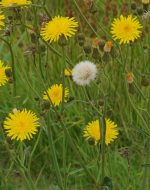
Perennial sowthistle is a herbaceous perennial and a member of the aster family, Asteraceae, that also includes daisies, yarrow, and lettuce. It is native to Europe and western Asia but was introduced into the US by 1814 and now occurs throughout most of the country with the exception of Alabama, Arizona, Arkansas, Florida, Georgia, Hawaii, Oklahoma, and South Carolina. Plants prefer disturbed sites in full sun to part shade with moist, slightly alkaline to neutral soils and can be found in a variety of habitats including riparian areas, wetlands, croplands, fields, meadows, woods, lawns, gardens, ditches, roadsides, railroad right of ways, and waste areas.
Description: Plants have a stout taproot with spreading rhizomes and grow two to five feet tall. They have dull green hairless stems that are branched and contain a milky sap. The alternate sessile leaves are most numerous in the lower part of the stem and are up to twelve inches long becoming smaller as they ascend. Each leaf is lanceolate to ovate and has two to five lobes with toothed margins that are tipped with spines. The fragrant dandelion-like flower heads appear in loose branching terminal clusters from summer into fall and open after sunrise, closing at noon. They are up to two inches across and consist of numerous yellow ray flowers. The fruit is a dark brown achene with a tuft of white hairs to facilitate wind dissemination. Some seeds may be viable in cultivated soil for up to three years. Plants spread by seed and rhizomes and form clonal colonies.
Control: Mulch to discourage seed germination. Pull or hoe seedlings as they appear. Dig out large plants getting as much as the root system as possible since root fragments left in the soil will resprout. Repeat digging until no more sprouts appear which may take several years of effort. Dig, cut, or mow plants before they set seed but realize that mowing may stimulate sprouting. In severe cases herbicides can be applied at the pre bud or bud state. Several application per season may be necessary as plant bloom over an extended period of time. Effective herbicides include 2,4-D, dicamba, glyphosate, clopyralid, and picloram. A combination of mechanical and chemical control is most effective.